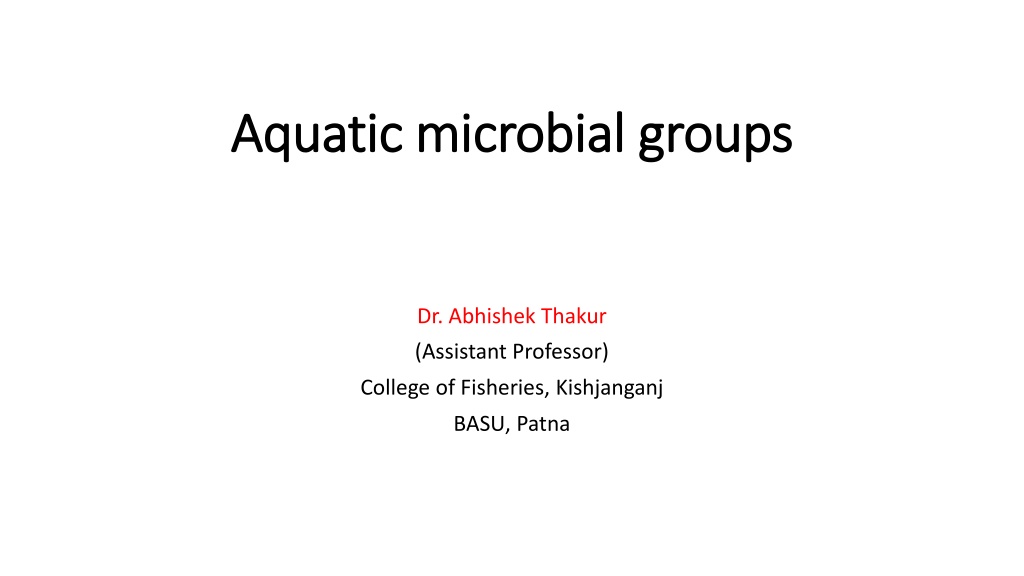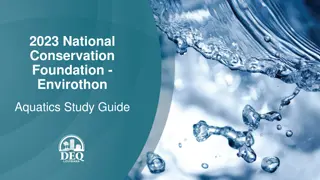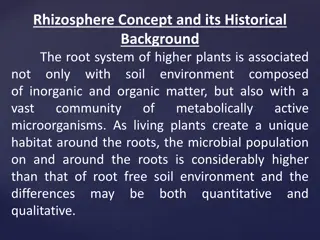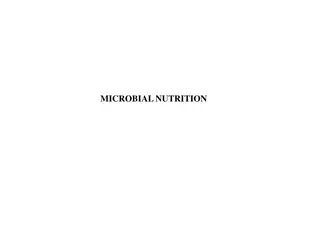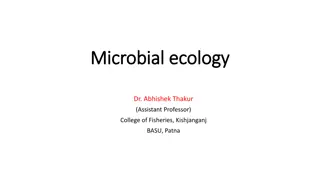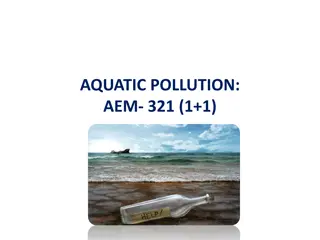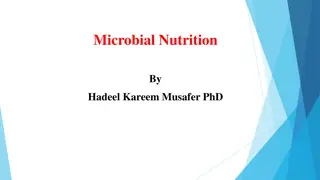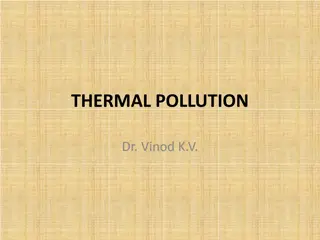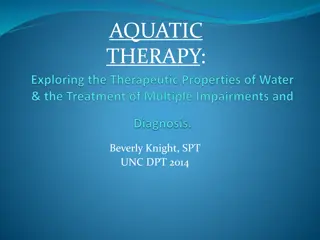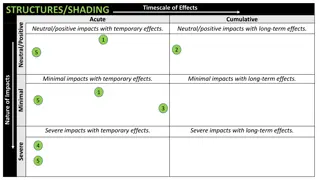Understanding Aquatic Microbial Groups and Their Environments
Explore the diverse world of aquatic microbial groups, their distribution in different water bodies, and their roles in ecosystems. Learn about the factors influencing microbial growth in water, the impact of eutrophication, bioremediation strategies, and the unique microbial communities found in estuaries and marine environments.
Download Presentation

Please find below an Image/Link to download the presentation.
The content on the website is provided AS IS for your information and personal use only. It may not be sold, licensed, or shared on other websites without obtaining consent from the author. Download presentation by click this link. If you encounter any issues during the download, it is possible that the publisher has removed the file from their server.
E N D
Presentation Transcript
Aquatic microbial groups Aquatic microbial groups Dr. Abhishek Thakur (Assistant Professor) College of Fisheries, Kishjanganj BASU, Patna
Generally, the concentration of bacteria in water is proportional to the amount of organic material in the water.
Freshwater Microbiota Freshwater Microbiota Number and location of freshwater microbiota depend on the availability of oxygen and light. Littoral zone: Limnetic zone is the open surface water area away from the shore. The profundal zone is the deeper water below the limnetic zone. The benthic zone is the deepest zone with sediment at the bottom. Photosynthetic algae are the primary producers of a lake. They are found in limnetic zone.
Microbial growth in stagnant water uses available oxygen and cause eutrophication. Purple and green sulfur bacteria : in the profundal zone There are light and H2S but no oxygen. Benthic zone Desulfovibrio reduces SO4to H2S in benthic mud. Methane producing bacteria are also found in this zone.
In small water bodies: Phosphates cause algal blooms, lead to eutrophication. Eutrophication is the result of addition of pollutants or natural nutrients. Use of microorganisms to remove pollutants is called bioremediation.
Estuarine microbiota Estuarine microbiota An estuary is an interface between fresh and marine habitats. This results in a body of water that is brackish in nature. Most organisms in estuaries are from either fresh or salt water origins. The rapid variations in physical and chemical properties in estuaries lead to the establishment of unique microbial communities. The biomass in estuaries is high due to high nutrient levels. The sediment conditions fluctuate less than the water.
Marine microbiota Marine microbiota The marine environment is by far the largest part of the biosphere. About 75% of the ocean is below 1000 M depth and is constantly cold. Pressure differences lead to different microorganisms at different depths. Barophiles, moderate (growing best at 400 atm but able to grow at 1 atm) or extreme (grow only at higher pressures). Barotolerant - growing best at lower pressures, but tolerate up to 400 atmospheres.
Many marine bacteria have an absolute requirement for sodium, potassium and magnesium ions. Some also require chloride ions and ferric iron. Heterotrophic bacteria in the pelagic and deep ocean are often oligotrophic. Psychrotrophic or psychrophilic . Microbial luminescence is seen in deep-sea life.
Phosphorous Cycle Phosphorous Cycle Phosphorus is only second to nitrogen as a mineral nutrient required for plants, animals and microorganisms. It is a major constituent of nucleic acids and in all living systems, it is essential for the accumulation and release of energy. This element is generally added to the soil as a chemical fertilizer or in the form of organic phosphates present in plant residues.
Phosphorous Cycle Phosphorous Cycle Microorganisms play a key role to bring about a number of transformations of this element. These include (i) altering its solubility, (ii) mineralization of organic phosphate into inorganic phosphate, (iii) oxidation and reduction of phosphorus compounds. Of these mobilization and immobilization are the most important. Upon the death of the plants, the organic phosphate is rapidly released by enzymatic hydrolysis. In many instances, phosphate becomes limiting factor for plant growth, because much of it in the soil is bound as insoluble calcium, iron or aluminium phosphates.
Phosphorous Cycle Phosphorous Cycle The availability of phosphates depends on the degree of solubilization of insoluble phosphates by various organic and inorganic acids produced by microorganisms. Several soil microorganisms, particularly fungi are known to produce substantial amounts of these acids and thereby solubilize insoluble phosphates and make it available to the plants. Important microorganisms active in solubilization of inorganic phosphates include both bacteria and fungi such as species of Bacillus, Pseudomonas, Micrococcus, Aspergillus, Penicillium and Fusarium. The enzyme phosphatase plays key role in the solubilization of organic phosphates.
Carbon cycle Carbon cycle In nature, carbon exists in the form of inorganic and complex organic compounds. In atmosphere the concentration of CO2is only 0.32 per cent which is less than what is required by plants for photosynthesis. The CO2is the main source of carbon required to build the organic world. The CO2returns back into the atmosphere through the process of respiration by all groups of organisms. The other method of returning carbon is through degradation (decomposition) of organic matter by microorganisms.
